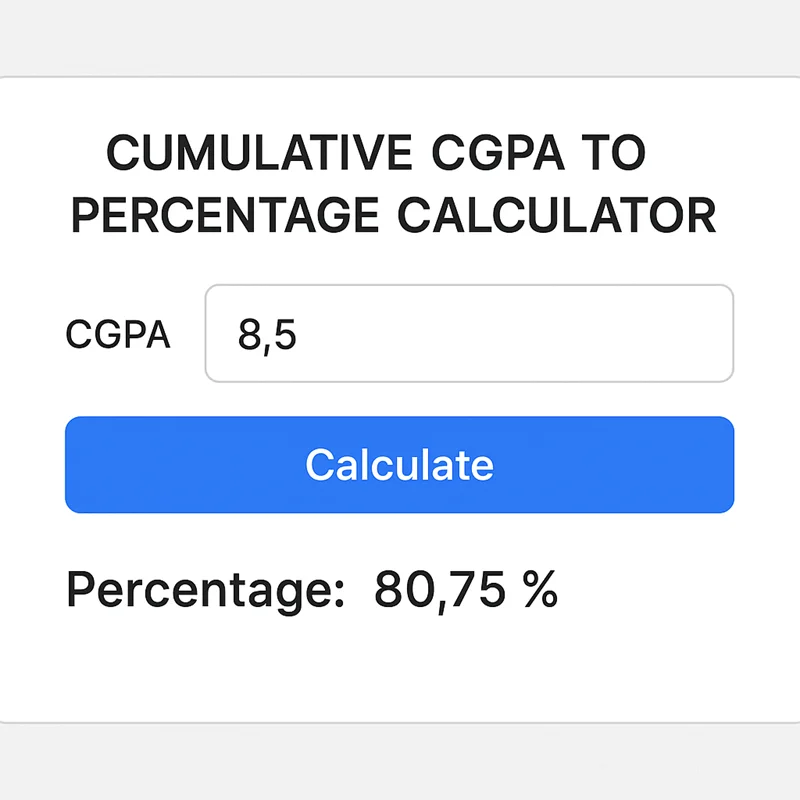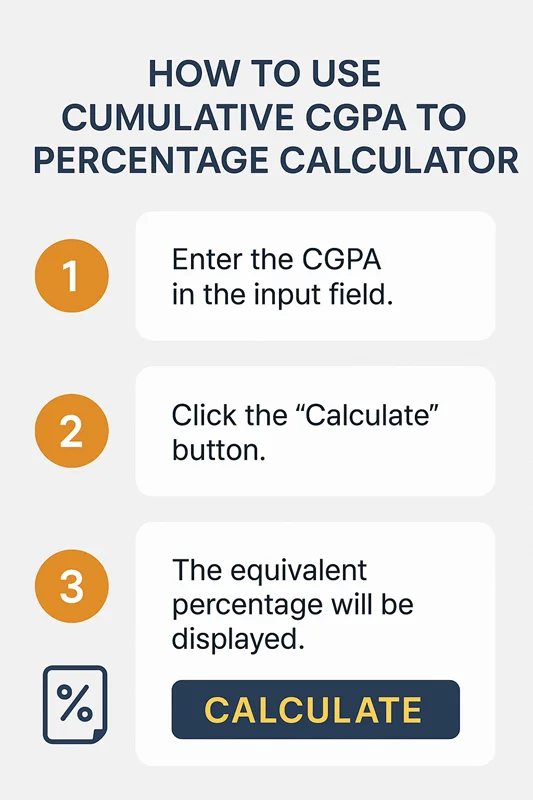Convert your Cumulative CGPA to Percentage instantly
| Aspect | CGPA | SGPA |
|---|---|---|
| Scope | All semesters combined | Single semester only |
| Calculation Period | Entire course duration | One semester |
| Usage | Final transcripts, job applications | Semester-wise progress tracking |
| Weightage | Considers all completed semesters | Limited to current semester subjects |

| CGPA | Percentage | Grade | Performance Level |
|---|---|---|---|
| 10.0 | 95.0% | O (Outstanding) | Exceptional |
| 9.5 | 90.25% | A+ (Excellent) | Excellent |
| 9.0 | 85.5% | A+ (Excellent) | Excellent |
| 8.5 | 80.75% | A (Very Good) | Very Good |
| 8.0 | 76.0% | A (Very Good) | Very Good |
| 7.5 | 71.25% | B+ (Good) | Good |
| 7.0 | 66.5% | B+ (Good) | Good |
| 6.5 | 61.75% | B (Above Average) | Above Average |
| 6.0 | 57.0% | B (Above Average) | Above Average |
| 5.5 | 52.25% | C (Average) | Average |
| 5.0 | 47.5% | C (Average) | Average |
| 4.0 | 38.0% | D (Below Average) | Pass |
| CGPA | Percentage | CGPA | Percentage | CGPA | Percentage |
|---|---|---|---|---|---|
| 8.1 | 76.95% | 8.2 | 77.9% | 8.3 | 78.85% |
| 8.4 | 79.8% | 8.5 | 80.75% | 8.6 | 81.7% |
| 8.7 | 82.65% | 8.8 | 83.6% | 8.9 | 84.55% |
| 9.1 | 86.45% | 9.2 | 87.4% | 9.3 | 88.35% |
| 9.4 | 89.3% | 9.6 | 91.2% | 9.7 | 92.15% |

The CGPA × 9.5 formula is the most commonly used method in India, recommended by UGC for the Choice Based Credit System (CBCS). However, it's not universally accepted by all institutions. Some universities use alternative formulas like (CGPA - 0.75) × 10 or CGPA × 10. Always verify with your specific university's conversion policy to ensure accuracy.
Yes, you can convert SGPA to percentage using the same formula your university applies for CGPA conversion. However, remember that SGPA represents performance for a single semester, while CGPA represents cumulative performance. For job applications or admissions, institutions typically require cumulative CGPA conversion rather than individual semester conversions.
For multiple degrees, convert each CGPA separately using the respective university's formula. If you need an overall percentage across degrees, you'll need to calculate a weighted average based on:
If your university doesn't specify a conversion formula:
Generally, the conversion formula remains the same regardless of discipline. However, some technical universities or engineering colleges may use modified formulas to account for:
Always verify with your specific engineering college or technical university for their exact conversion method.
Converting cumulative CGPA to percentage accurately is essential for students navigating admissions, job applications, and various academic requirements. While the standard CBCS formula (CGPA × 9.5) is widely accepted, remember that university-specific variations exist.
Key Takeaways for Accurate Conversion:
The 10-point grading system and CGPA conversion will continue to be relevant as Indian education systems standardize further. Stay updated with your institution’s policies and use trusted tools and formulas for accurate results.
Remember that while conversion tools and calculators provide convenience, official documentation from your university carries the most weight in formal applications. When in doubt, always consult your academic office or Controller of Examinations for authoritative conversion methods and certificates.
Whether you’re planning for higher studies, preparing job applications, or filling competitive exam forms, accurate CGPA to percentage conversion ensures you present your academic achievements correctly and maximize your opportunities for success.